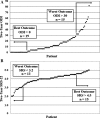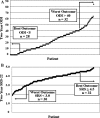Clinical and radiographic parameters that distinguish between the best and worst outcomes of scoliosis surgery for adults
- PMID: 23073746
- PMCID: PMC3555616
- DOI: 10.1007/s00586-012-2547-x
Clinical and radiographic parameters that distinguish between the best and worst outcomes of scoliosis surgery for adults
Abstract
Purpose: Predictors of marked improvement versus failure to improve following surgery for adult scoliosis have not been identified. Our objective was to identify factors that distinguish between patients with the best and worst outcomes following surgery for adult scoliosis.
Methods: This is a secondary analysis of a prospective, multicenter spinal deformity database. Inclusion criteria included: age 18-85, scoliosis (Cobb ≥ 30°), and 2-year follow-up. Based on the Oswestry Disability Index (ODI) and the SRS-22 at 2-year follow-up, patients with the best and worst outcomes were identified for younger (18-45) and older (46-85) adults with scoliosis. Clinical and radiographic factors were compared between patients with the best and worst outcomes.
Results: 276 patients met inclusion criteria (89 younger and 187 older patients). Among younger patients, predictors of poor outcome included: depression/anxiety, smoking, narcotic medication use, older age, greater body mass index (BMI) and greater severity of pain prior to surgery. Among older patients, predictors of poor outcome included: depression/anxiety, narcotic medication use, greater BMI and greater severity of pain prior to surgery. None of the other baseline or peri-operative factors assessed distinguished the best and worst outcomes for younger or older patients, including severity of deformity, operative parameters, or the occurrence of complications.
Conclusions: Not all patients achieve favorable outcomes following surgery for adult scoliosis. Baseline and peri-operative factors distinguishing between patients with the best and worst outcomes were predominantly patient factors, including BMI, depression/anxiety, smoking, and pain severity; not comorbidities, severity of deformity, operative parameters, or complications.
Figures


References
-
- Schwab F, Dubey A, Gamez L, El Fegoun AB, Hwang K, Pagala M, Farcy JP. Adult scoliosis: prevalence, SF-36, and nutritional parameters in an elderly volunteer population. Spine. 2005;30:1082–1085. doi: 10.1097/01.brs.0000160842.43482.cd. - DOI - PubMed
-
- Smith JS, Shaffrey CI, Berven S, Glassman S, Hamill C, Horton WC, Ondra S, Schwab F, Shainline M, Fu KG, Bridwell KH. Operative versus nonoperative treatment of leg pain in adults with scoliosis. A retrospective review of a prospective multicenter database with two-year follow-up. Spine. 2009;34:1693–1698. doi: 10.1097/BRS.0b013e3181ac5fcd. - DOI - PubMed
-
- Smith JS, Fu KM, Urban P, Shaffrey CI. Neurological symptoms and deficits in adults with scoliosis who present to a surgical clinic: incidence and association with the choice of operative versus nonoperative management. J Neurosurg Spine. 2008;9:326–331. doi: 10.3171/SPI.2008.9.10.326. - DOI - PubMed
Publication types
MeSH terms
LinkOut - more resources
Full Text Sources
Medical
Miscellaneous

